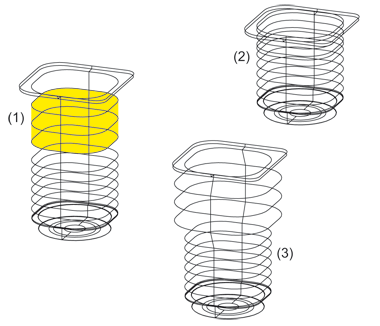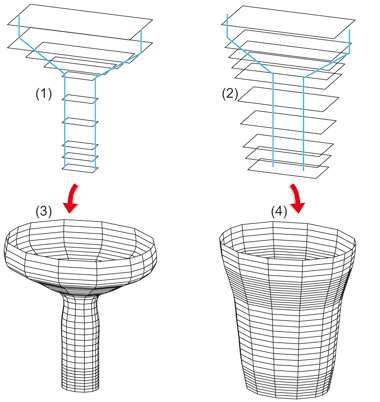Scale Cross-Sections
Scale cross-sections
3-D FFS > From c-edges > Framew  . >Scale cross-sections
. >Scale cross-sections 
This function enables you to scale cross-sections and change the distance between cross-sections. The prerequisite is that the active part should contain a frame with closed parallel cross-sections.
- HiCAD calculates the approximate mesh volume and displays the value that it has calculated. Enter the new value and choose OK to exit the value input window .
- Select the scaling method:
- Between cross-sections
The cross-sections are moved, thereby changing the height of the component. - In
cross-section plane
The cross-sections are scaled. This changes the size of the part in the scaling area, i.e. the form of the component.
- Specify the scaling area by identifying two cross-sections. HiCAD marks the cross-sections of the selected scaling area and asks you to confirm the selected area. Only after you have confirmed this control prompt, is the scaling performed.

(1) Original frame with scaling area, (2) Scaling between the cross-sections, (3) Scaling in the cross-section plane
Scale cross-section sequence
3-D FFS > From c-edges > Framew  . > Scale cross-section sequence
. > Scale cross-section sequence 
You use this function to scale a sequence of cross-sections by specifying a surface calculation formula. Each cross-section of the sequence is scaled in such a way that it has the surface content predefined by the formula.
- Activate the frame.
- Call the function.
- Enter the surface calculation formula O(T).
- Specify the start and end values of parameter T. HiCAD automatically calculates the corresponding scaling factor from the specified intervalfor T and the calculation formula and displays it so that you can check it for each cross-section. You can confirm or, if necessary, correct the displayed value.
In the following figure, 1000 * EXP(T) has been selected as the calculation formula. The default setting 0.00 (start value) and 1.00 (end value) has been transferred for the start and end value of T. 10 cross-sections exist.
The cross-sections are scaled in guideline direction so that they have the following surface content:
1st cross-section: 1000
* EXP(T1) T1 = 0
nth cross-section: 1000 * EXP(Tn) Tn = (n-1)*(TEnd - TStart/No.C-S
- 1)
(n=2 to No.C-S)
where TEnd is the end value of T, TStart the start
value of T and No.C-S the number of cross-sections.
In the depicted example, this results in an increment of 1/9 for parameter T, given 10 cross-sections.

(1) Formula: 1000*EXP(T), T-interval [0,1]
(2) Scaled frame, (3,4) Derived freeform surfaces

Process Cross-Sections (3-D) • Process C-Edges (3-D) • Sketch Functions (3-D) • Working with Sketches (3-D)
